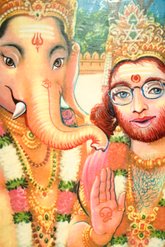
The items that you decide to take on a long-distance hike are your business. If you want to bring your lucky cinder block along, that's up to you. But, when you have to lug an object endlessly up and down mountains, you quickly discover for yourself if its useful enough to haul around or not. If you don't use something at least once in an average day of hiking (except medicine or other emergency supplies) you need to seriously consider chucking it. Editing items out of your pack is a lot like editing a piece of writing, you often have to "kill your darlings" and leave cherished things behind. When I started my Appalachian Trail thru-hike in February 2006, I thought that I had a pretty good base of knowledge about what I needed to take. I had spent a lot of time as a kid growing up in upstate New York tramping around the woods and camping with my Dad, and I had just lived for 3 years in decidedly less-than-posh circumstances in a tribal village in rural South Africa. I also took the two months before my hike to get things together, yet I still made a lot of mistakes. I later found out that some people spend years putting together and testing the items needed for a successful A.T. thru-hike. Because of some of the older gear that I used and things I didn't take that other hikers count as essential items, I was damn lucky that I made it as far as I did. When I started, I was carrying way too much food (say enough for the Chinese Army,) but I soon figured out how much I needed to carry to hike a given distance. During early weeks of my hike, I received a lot of unsolicited advice concerning the type of things that I should be carrying. Hikers compare gear like dogs sniff assholes. I'm sure that most of this talk was good-natured and natural, because gear is something that all hikers have in common, but I soon grew very tired of it. People were always showing me fancy and expensive gear that was way beyond my price range and skill level. I remember running into a guy who claimed that the was hiking the 2,175-mile A.T. as an "appetizer" for his 2,600-mile Pacific Crest Trail thru-hike, who stopped in the middle of the trail and pulled everything out of his pack telling me each item's cost and weight in turn. This is the type of fetishistic Keeping-Up-With-The-Joneses aspect of hiking is exactly the thing that I went into the woods to avoid. I guess no matter where guys go (the locker room or the U.N.) they wind up comparing their junk. With this in mind, I'm going to tell you what I learned about gear during my hike. I don't recommend any particular brands of gear. I only mention brand names in this essay when I don't know the generic alternative. THINGS I DIDN'T TAKE:(1) A HATCHET OR SAW-Most thru-hikers are way too tired at the end of the day to build fires. If you do have the energy, there is usually plenty dead fall and dry leaves around-no need to chop down a living tree and burn smoky green wood. Plus, Do you know how heavy that shit is? (2) A PISTOL-Dear, Grizzly Adams-this is the 21st century and you can hitchhike into town from the A.T. and get your vittles. There isn't much in the forest to shoot, except for your own foot. Leave the widowmaker at home, Hoss. (3) A BEAR BELL OR PEPPER SPRAY-If you hang your food an appropriate distance and height from where you sleep at night and don't cook in or next to your tent it is very unlikely that bears will bother you, though female hikers may want want to keep the pepper spray to fend off the Pink-Blazers. The Sexy Monk's trail dictionary defines a "pink-blazer" as a male thru-hiker who constructs elaborate plans to remain in the vicinity of a female thru-hiker in the largely futile attempt to gain entry to her sweaty hiking panties. In normal life a guy exhibiting this behavior is called simply a "stalker." Though I feel sorry for the women in these situations, all of the female hikers I knew were more than capable of handling themselves. Plus, news of anything really inappropriate would have rocketed up and down the trail in no time. I can also sympathize with the guys just a little on this one. Weeks and weeks alone in the forest with only Mother Thumb and her four daughters for company, and then...KA-BOOM! There is a real girl right in front of you. On the trail, girls you would you would usually describe as being "like a sister" or as "a real pal" take on a fascination unmatched by the perfumed harems of the Orient. While in the green tunnel, its easy to be hypnotized by the pink tunnel. (4) SLEEPING PAD (Thermarest) -I spent a lot of uncomfortable nights, because I pinched pennies and didn't get one. There always seemed to be a pebble or stick that worked its way between your shoulder blades during the night, causing me to loose sleep. On my next long distance hike, a good light weight sleeping pad will be the first thing in my pack. (5) A CAMP STOVE -Most of my fellow hikers thought I was crazy for not at least carrying a little alcohol burning stove. Miss Janet (Miss Janet's Hostel in Erwin, Tennessee- fantastic place) even made me one out of two beer cans squashed together, but I never used it. I got used to cold food on the trail and it didn't bother me. Lots of times I would find dehydrated precooked food in hiker boxes, add in a little creek water, seal it back up, walk for a couple of hours, and then enjoy the re-hydrated goodness. The Sexy Monk's trail dictionary defines a "hiker box" as a receptacle in which hikers place unwanted items of food, clothing, or gear for other hikers to find and use as they see fit. Hiker boxes are commonly found in motels, hostels, and post offices in towns along the A.T. (6) A CELL PHONE -I didn't take one, but I wish I had. People with cell phones didn't have a signal in the valleys, but they usually got one in town or on some of the higher peaks. On the trail, cell phones are not the annoying accessories that they are in the city. They have the potential to be very helpful in an emergency, though not as useful as a saint bernard with a barrel of brandy around its neck. THINGS I DID TAKE, BUT TOSSED LATER-(1) A WATER FILTER PUMP-When I started my hike I used an old pump filter that I had bought few years earlier to use in India. This contraption worked well, but was bulky and hard to keep clean. When I stupidly sucked sand up into it an fouled up the works in southern Virginia, I replaced it with water treatment drops (Aqua Mira) that were much lighter and worked just as well. When the drops ran out (in southern New Hampshire) and I couldn't find a replacement, I switched to carrying a little bottle of bleach. If I took water from a source I didn't completely trust, I would add in a few drops of bleach, swish it around, and let it sit for a little while. I'm not sure if this did any good or not but I never got sick from bad water while I was hiking. During the year I lived in India, I had one serious intestinal malady after another, so maybe I've got good poop-karma built up. (2) ORANGE PLASTIC POOP SHOVEL - When you hear nature's call (or shout) its not always near a privy. I carried a little shovel to dig cat holes in the woods until I discovered that stout stick or the end of a hiking pole works just as well. (3) PACK COVER-A pack cover is like a big shower cap that fits around the outside of your rucksack. In my experience, pack covers always ALWAYS leak. Water seeps around from the exposed back of the pack and collects on the bottom soaking just about everything. Its so frustrating to hike all day in the rain and have to curl up and go to sleep in a wet sleeping bag. I did it several times and it is truly miserable. I found that wrapping your vulnerable gear (sleeping bag, extra socks, journal, guide book) in heavy duty garbage bags (trash compactor bags, if you can find them) keeps you things much drier. THINGS I DID TAKE-(1) AN EXTRA SET OF CLOTHES -Some hostels along the trail have pile of old clothes that you can wear while you wash your astoundingly smelly trail clothes, but not all do. In towns without hostels, this requires the hiker with one set of clothes to sneak to the back of the laundromat and change into his rain poncho while his clothes were being cleaned and then sneak back and change into his clothes again. As much as I respect the ingenuity shown by these hikers, I feel that this situation uncomfortably blurs the line between "outdoorsman" and "flasher." This goes double for the fashion of male hikers wearing so called "hiking kilts." (2) A RADIO -Most people on the trail did not have a radio, but I found it endlessly useful and entertaining. The A.T. induces a state if Buddha-like peace and tranquility, but even the Dalai Lama likes to get down and boogie from time to time. I carried a little 20$ Sony model with AM/FM/TV band/Weather band-weight: all of about 3 ounces. I remember rocking down a hill in North Carolina at full speed while singing along to "Roxanne"and nearly crashing into an astoundingly beautiful girl walking a tall white dog who said, "Jesus! You've been out here a long time, haven't you?" Plus the weather band kept me from pushing on into hail or thunderstorms-worth its weight in gold. (3) A TENT- A lot of the ultra-light hiking crowd get away with carrying two hiking poles and a rain poncho, but I consider this a poor excuse for a shelter. There are times when the lean-tos are full, or you feel like pushing on, or the weather forces you to give up for the day. I loved my tent, and I would sometimes spend whole zero days (days where I hiked zero miles/ days off) parked in a field just drawing, reading, and soaking up the sun. These were some of my sweetest days on the trail. I remember them much better than the times that I just ground it out. Whether you're an old skool external frame character or a hard core fascist who trims every other hair off his toothbrush before setting out, I think we can all agree that the most essential piece of gear can't be found at any hiking store. It weighs about three pounds, comes in only one color, and sits comfortably between your ears.



No comments:
Post a Comment